Sharp R-870B: MANUAL OPERATIONS
MANUAL OPERATIONS: Sharp R-870B

E – 8
MANUAL OPERATIONS
Microwave Cooking Techniques
Arrange food carefully
Watch cooking time
Cover foods before cooking
Stir foods
Turn foods
Rearrange foods
Allow standing time
Check for doneness
Shield foods
Condensation
Place thickest areas toward outside of dish.
Cook for the shortest amount of time indicated and add more time
as needed.
Food severely overcooked can smoke or ignite.
Check recipe for suggestions: paper towels, microwave plastic
wrap or a lid.
Covers prevent spattering and help foods to cook evenly.
(Helps keep oven clean)
Use small pieces of aluminium foil to cover thin areas of meat or
poultry in order to avoid overcooking.
From outside to center of dish once or twice during cooking, if
possible.
Foods such as chicken, hamburgers or steaks should be turned
over once during cooking.
Like meatballs halfway through cooking both from top to bottom
and from the center of the dish to the outside.
After cooking ensure adequate standing time.
Remove food from oven and stir if possible.
Cover during standing time can allow the food to finish cooking
completely.
Look for signs indicating that cooking temperature has been
reached. Doneness signs include:
– Steam emits throughout the food, not just at edge;
– Joints of poultry can be torn apart easily;
– Pork and poultry show no pinkness;
– Fish is opaque and flakes easily with a fork.
A normal part of microwave cooking. The humidity and moisture
in food will influence the amount of moisture in the oven. Gener-
ally, covered foods will not cause as much condensation as
uncovered foods. Ensure that the ventilation openings are not
blocked.
For cooking food with high fat content, do not bring the wrap in
contact with the food as it may melt.
Some microwave safe plastic cookware are not suitable for cook-
ing foods with high fat and sugar content.
Microwave safe plastic wrap
Microwave safe plastic
cookware
Оглавление
- VTHS GHTLJCNJHJÖZJCNB
- JCJ>ST ERFPFZBY
- BZCNHERWBY GJ ECNFZJDRT
- HF>JNF C CTZCJHZJQ GFZTKM* EGHFDKTZBY
- 1 2 3 4 5 6 7 8 9 0
- 1
- 2
- JCJ>ST ERFPFZBY
- 1
- 1
- 3
- 23
- 2
- 34
- 1
- 23
- 2 1
- FDNJVFNBXTCRBT JGTHFWBB
- 1
- ÜP-3 ÜP-3ÜP-3 ÜP-3ÜP-3
- 12
- HTWTGNS LJVFIZTQ GBWWS
- 12
- FU-1 FU-1FU-1 FU-1FU-1
- 1
- FÖ-1FÖ-1FÖ-1FÖ-1FÖ-1
- 13
- AB-2AB-3AB-1
- 1
- H-1H-1H-1H-1H-1H-3H-3H-3H-3H-3
- 1 2
- 1
- G-2
- 1
- 43265
- 3
- 1
- EÜJL PF GTXM*
- NTÜZBXTCRBT ÜFHFRNTHBCNBRB
- WARNING
- SPECIAL NOTES
- INSTALLATION INSTRUCTIONS
- OPERATION OF TOUCH CONTROL PANEL
- 1 2 3 4 5 6 7 8 9 0
- 112
- 1
- MANUAL OPERATIONS
- 2
- 213
- 3
- 1 23
- 2
- 1
- 1
- 23
- 5
- AUTOMATIC OPERATIONS
- 3
- 2
- HOMEMADE PIZZA RECIPES
- 2
- 2
- 2314
- Auto Bake Recipe
- 1
- 1
- 21
- SENSOR STEAM MENU RECIPES (Meat)
- 1
- 1
- 3
- 1
- 14
- CARE AND CLEANING
- SPECIFICATIONS






